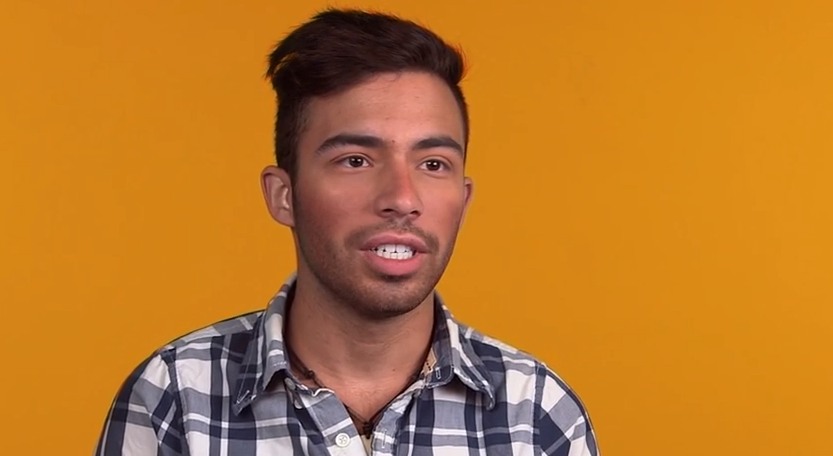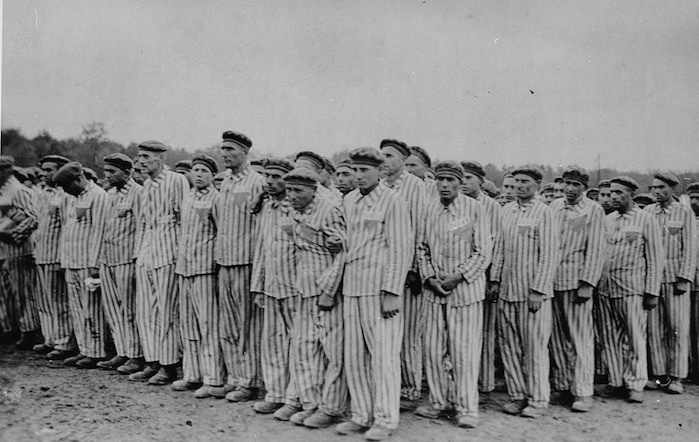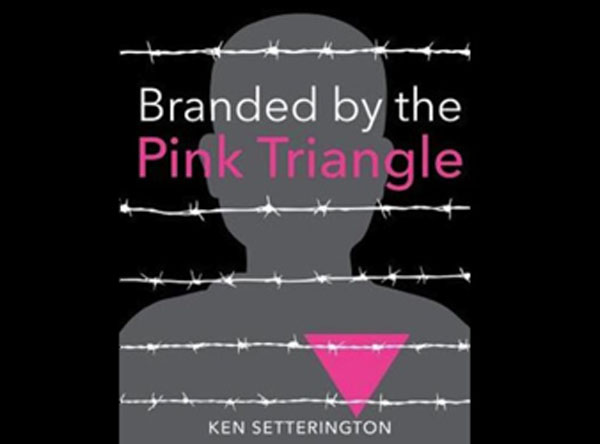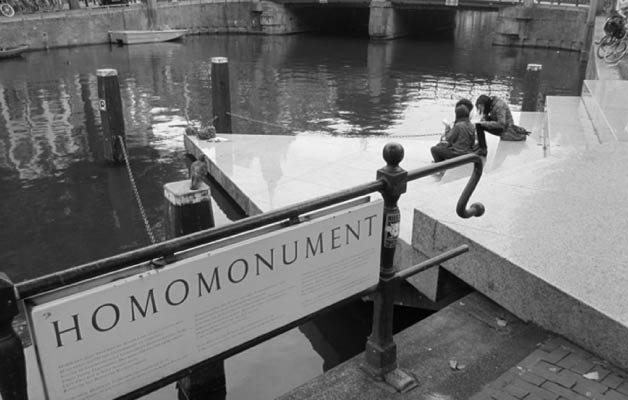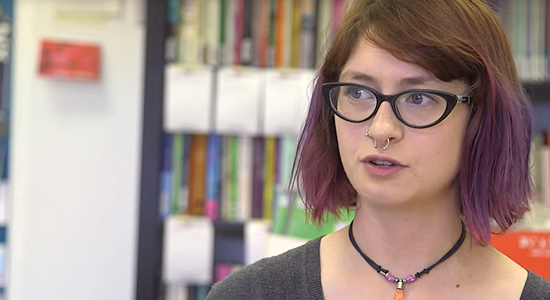Educator Tools

 Ask yourself:
Ask yourself:
- What is homophobia and how does it impact those around you?
- Have you witnessed homophobia in your own life? Have you heard homophobic comments? How did it make you feel?
- What can be done to protect people from the damaging effects of homophobia?
The actions in this chapter invite you to discuss issues connected to homophobia and prejudice and to explore how the pink triangle, a mark of persecution for gay men in Nazi Germany, has become a symbol of both remembrance and celebration today.
How homophobic are you?
For much of the twentieth century, homosexuality was defined by the medical and scientific communities as a psychiatric disorder. In 1974, the Diagnostic and Statistical Manual (DSM) of the American Psychiatric Association (APA) was updated and homosexuality was replaced with a new diagnostic code for individuals distressed by their homosexuality. Distress over one’s homosexual orientation remained in the manual, under different names, until the DSM-5 in 2013. Today, research emphasis has shifted to the other side of the problem: the study of the negative, sometimes pathological, reactions to homosexuals by heterosexuals.
The term homophobia encompasses a range of negative attitudes and feelings toward homosexuality or people who are identified or perceived as being lesbian, gay, or bisexual. Since the early 1980s, scientists attempting to measure homophobia have developed a number of different homophobia scales and questionnaires.
In 1996, as part of his study on homophobia, Dr. Henry Adams and his colleagues at the University of Georgia developed their own “Homophobia Scale” by modifying scales used by other researchers in earlier studies. It’s a 25-item questionnaire “designed to measure your thoughts, feelings and behaviors with regard to homosexuality.” The instructions stressed: “It is not a test, so there are no right or wrong answers.”
Fill out the questionnaire online and discuss the results with a classmate or two.
ACTION 1
Discuss
Let’s talk about homosexuality, prejudice and discrimination
Form groups to discuss issues connected to homophobia and prejudice.
A. You will need a single die. Each player in turn will roll the die and whatever number appears, that is his or her assigned topic listed below to discuss. You will offer your opinion on one of the topics, by sharing your reactions, making connections, and asking questions. Once completed, another person rolls the die and discusses the corresponding topic. Note: it is okay if two players discuss the same topic. If someone rolls a six they can choose a topic of choice.
B. The activity is repeated. This time, the group members contribute by having a conversation about the topic. There is no time limit. Alternatively, the group can choose one topic to focus on:
- There is nothing wrong with men who choose to wear pink clothing.
- Having a GSA (Gay Straight Alliance) in the school is helpful.
- Every country should legalize gay marriage.
- I know a story about a homophobic incident.
- I have a strong reaction when I hear someone using the word “faggot.”
- Choose a topic.
ACTION 2
Do
Nazism and Homosexuality
The Nazi Party did not need to create new laws in Germany to prohibit homosexuality. Paragraph 175 was a law against homosexuality that prohibited sex between men. Since the law was already in existence, all the Nazis had to do was enforce it. Paragraph 175 dated back to the year of German unification (1871). It stated: “a man who commits indecency with another man, or allows himself to be misused indecently, will be punished with prison.”
Pink became the colour of persecution for gay men in Nazi Germany. Those who were arrested by the regime had a pink triangle sewn onto the left side of their prison uniforms. The persecution of homosexuals was part of Hitler’s plan to strengthen the “Aryan” race. The “Aryan” race was proclaimed biologically superior to all others, according to Hitler’s regime.
The Nazis believed that men and women had traditional gender roles with specific obligations to society and the state. Men were to be soldiers and fathers and women were to be mothers of large families and take care of the home. Gay men and women, as well as feminism or any thought of female independence and empowerment, were seen as impediments to the Nazi understanding of family life and national or “racial” regeneration. And so they were removed from society.
Between 5,000 and 15,000 gay men were arrested and sent to concentration camps in Germany. We do not know how many died but we know that gay prisoners suffered terrible abuse at the hands of guards and other prisoners, were experimented upon, sexually assaulted, castrated, and perished in large numbers according to memoirs written by Holocaust survivors.
One unique aspect of the gay experience under Nazism is that these men did not experience a “liberation” like all other prisoners. Paragraph 175 remained in place in Germany until March 10, 1994. Some men were not released from prison after the Nazi regime collapsed in 1945 and tens of thousands of gay men were arrested in the decades following WWII.
Read about Josef Kohout’s memoir, The Men with the Pink Triangle
Read about the gay experience under Nazism.
“It is not necessary that you and I live, but it is necessary that German people live. And it can only live if it can fight, life means fighting. And it can only fight if it maintains its masculinity. It can only maintain its masculinity if it exercises discipline, especially in matters of love. Free love and deviance are undisciplined. Therefore, we reject you, as we reject anything that hurts our nation. Anyone who thinks of homosexual love is our enemy. We reject anything which emasculates our people and makes it a plaything for our enemies, for we know that life is a fight, and it is madness to think that men will ever embrace fraternally. Natural history teaches us the opposite. Might makes right. The strong will always win over the weak. Let us see to it that we can once again become strong! But this we can achieve only in one way—the German people must once again learn how to exercise discipline. We therefore reject any form of lewdness, especially homosexuality, because it robs us of our last chance to free our people from the bondage which now enslaves it.”
~Richard Plant, The Pink Triangle, 50.
ACTION 3
Do
Exploring facts about those who were “branded” by the pink triangle
In his book Branded by the Pink Triangle, author Ken Setterington brings to life the untold stories of bravery and perseverance of gay men who were imprisoned in Nazi concentration camps.
Just the Facts
Ken Setterington, a storyteller, book reviewer, author, and librarian did extensive research on the topic of the persecution of gay men and women during the Nazi regime. Some of the following statements appear in Setterington’s book. With a partner, decide if each of these statements is TRUE or FALSE.
- Many gay men joined the German army, hoping that they would be safe from arrest.
- The Nazis believed that if homosexuality was legalized, there would be fewer German babies and hence a lower birth rate, which would lead to a weaker Germany.
- Lesbians who were arrested and sent to concentration camps wore the pink triangle.
- In many concentration camps, gay men were housed apart because the Nazis believed that homosexuality was a disease that could spread to other prisoners.
- Some gay bars remained open during the Berlin Olympics in 1936.
- The gay community was not allowed to participate in the memorial services held at concentration camps or at war memorials.
- Even SS officers who were caught in homosexual acts were put in concentration camps.
- Rosa Winkel was the first lesbian to die in a concentration camp.
- German and other European governments provided the same compensation to gay people that was provided to other victims of the Nazi regime.
- There are less than ten known gay Jewish survivors of the Holocaust.
Scroll down to see answers at the end of this chapter.
The Pink Triangle Today
Silence=Death
In the 1970s, the pink triangle was chosen as a pro-gay symbol by activists in the United States. To transform a symbol of Nazi subjugation into one of solidarity and resistance, the pink triangle was turned upright (i.e., point at the top) instead of inverted. By the the onset of the AIDS epidemic in the 1980s, it was considered a symbol of gay pride and liberation.
The Silence=Death Project drew parallels between the Nazi period and the AIDS crisis. The project concerned those who chose not to discuss safer sex and who refused to fight government indifference to the disease. The men who created the project declared that “silence about the oppression and annihilation of gay people, then and now, must be broken as a matter of our survival.” The six men who created the Silence=Death Project offered the logo to the protest group ACT UP. ACT UP, or AIDS Coalition to Unleash Power, was founded in New York City in 1987 as a political action group in response to the AIDS crisis.
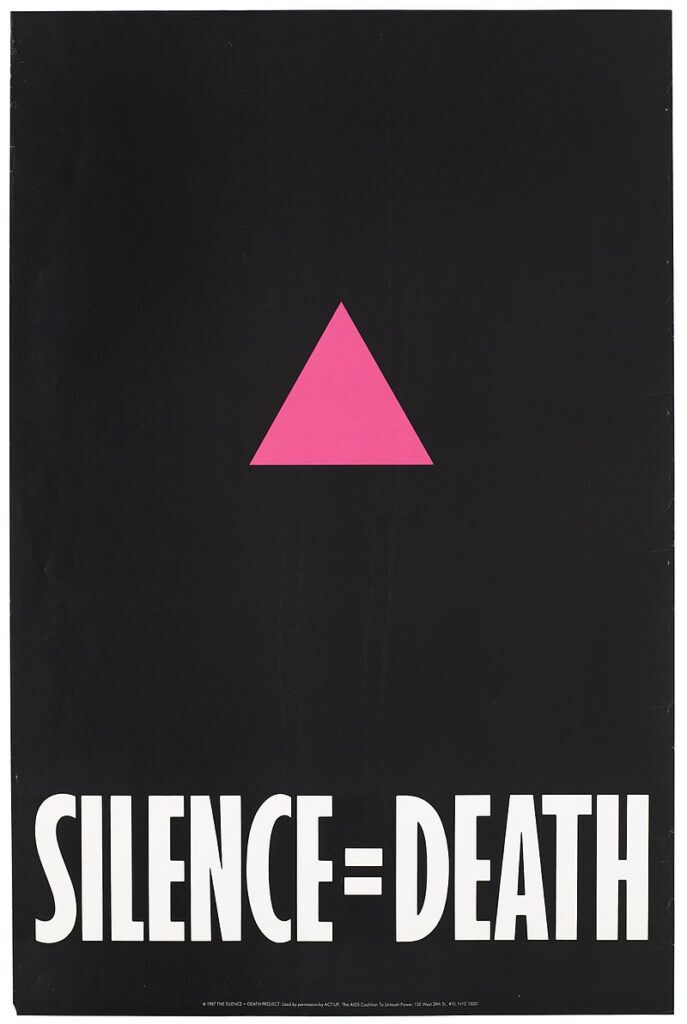
Monuments
1985 – a pink triangle plaque was finally displayed in Dachau. A memorial sculpture made up of triangles of many different colours had been previously created in the camp, but the pink triangle had been excluded.
1987 – the Homomonument was opened in Amsterdam, close to the Anne Frank House. Comprised of pink granite triangle “steps,” the monument is one of the largest in the world honouring gay men and women. The Homomonument is meant to “inspire and support gays in their struggle against denial, oppression and discrimination.”
1989 – in Berlin, a pink granite plaque in the shape of triangle was placed outside a subway station in the area of the city where gay culture was celebrated in the years before the rise of the Nazi regime. The plaque states: “Killed and forgotten, the homosexual victims of National Socialism.”
2008 – the Memorial to Homosexuals Persecuted under Nazism was unveiled in Berlin across the street from the Memorial to the Murdered Jews of Europe. Visitors to the monument look inside a small window to watch two alternating videos: either two young men kissing or two women kissing.
According to Ken Setterington, the video and the monument “act as a strong reminder that these two young men would certainly have been arrested and probably would have died if they had lived during the Nazi period” (101). The wording on a nearby plaque concludes:
Because of its history, Germany has a special responsibility to actively oppose the violation of gay and lesbian human rights. In many parts of the world, people continue to be persecuted for their sexuality: homosexual love remains illegal and a kiss can be dangerous.
With this memorial, the Federal Republic of Germany intends to honor the victims of persecution and murder, to keep alive the memory of injustice, and to create a lasting symbol of opposition to enmity, intolerance, and the exclusion of gay men and lesbians.
Awareness and Understanding
People are born heterosexual or homosexual, and some are bisexual. Young people who do not fit easily into the standard heterosexual mold often experience painful exclusion and bullying. Some of them even take their own lives out of desperation. In order to be compassionate and understanding, we must educate ourselves about the different types of people in our world.
It Gets Better
Following a number of tragic suicides by LGBTQ students who were bullied in school, columnist and author Dan Savage, along with his partner, uploaded a video to YouTube to inspire hope for LGBTQ youth who were facing harassment. The couple spoke openly about the suffering they endured as teenagers and shared the story of how they both came to lead rewarding adult lives. Their video launched the “It Gets Better Project” and initiated a worldwide phenomenon with thousands of videos posted.
The It Gets Better Project is a nonprofit organization with a mission to uplift, empower, and connect lesbian, gay, bisexual, transgender, and queer youth around the globe. Many celebrities have made videos about their own experiences and coming out stories–everyone testifies to the fact that IT GETS BETTER as you get older and leave school and make your own way into the wider world. School years are particularly challenging for young gay and queer people, but it gets better.
Watch Raven-Symoné share her story.
Milestones in the evolution of gay rights in Canada
- Homosexuality was decriminalized in Canada in 1969. Before that, individuals who engaged in sexual activity with others of the same sex risked long prison sentences.
- Rights and freedoms in the provinces: In 1977, Quebec became the first province to amend its Charter of Human Rights and Freedoms to prohibit discrimination based on sexual orientation. In the years that followed, all provinces and territories eventually followed suit, Alberta being the last, in 2009.
- Canadian Armed Forces: Sexual orientation was removed as a barrier to enrolment and promotion for military personnel in 1992.
- Hate crimes: Since 1996, the Criminal Code has provided stricter penalties for crimes motivated by hate based on certain personal characteristics, including sexual orientation.
- Spousal recognition: In 1999, the Supreme Court of Canada’s landmark decision in M. v. H. recognized same-sex couples as common-law partners. This was followed by provincial and federal legislation granting same-sex couples benefits and obligations similar to those that apply to other common-law couples.
- Same-sex marriage: In 2005, Canada legalized same-sex marriage by enacting the Civil Marriage Act. This led to amendments to other statutes granting same-sex couples equal access not only to the civil effects of marriage, but also to those of divorce.
- In 2017, PM Justin Trudeau apologized to gay and lesbian Canadians for the persecution and discrimination they endured. Read the transcript of the speech; you may be surprised to discover how gay people have been treated in this country until very recently.
ACTION 4
Do
Design a poster
Design a poster that features the Pink Triangle for an It Gets Better campaign.
Your posters can be displayed in the classroom, school, or in the community to help others understand the significance of the pink triangle as a symbol of remembrance, celebration, liberation, and pride.
- How will you feature one or more pink triangles in your design?
- Who is your audience?
- How will your poster draw attention? What message do you hope your poster will convey to others?
- What words, if any, will your poster have?
ACTION 5
Discuss
Engaged response: Taking action against homophobia
A. Why do people hate?
Examine the list of reasons below and rank them in order from #1 (strongest) to #6 (lowest). Once completed, share your list in groups of three or four. Are there any other reasons why you feel someone might be homophobic?
People might be cruel to others who identify as queer because:
___They are afraid of what they do not know. Someone might feel intimidated.
___They might never have had any close interactions with someone who identifies as queer.
___Religious or cultural beliefs that judge and condemn homosexuality.
___Some people are taught to hate or distrust what they do not know or understand.
___People go along with awful things because they need to feel accepted. Peer pressure can influence how we treat others.
___Bigots are often insecure. Insecure people often take out their own anxieties about themselves on others – especially those who are a minority. Intimidating others gives them power.
B. Triumphing over Haters
Examine the list of strategies below that outline actions someone might take if they are being harassed. Rank the list in order from #1 (strongest) to #6 (lowest).
Then, in small groups, discuss the pros and cons of each strategy.
If someone is being harrassed by others because of their sexual orientation, they should:
___Ignore the situation
___Talk to a trusted adult
___Confront the bully about his or her homophobia
___Seek professional counseling
___Ask your friends to help you approach the bully
___Other
ACTION 6
Discuss
Organizing a Gay-Straight Alliance (GSA) or a Respecting Difference Club
Dedicated to making schools more inclusive for all students, thousands of Gay-Straight Alliances (GSA) have been established in schools throughout North America. A GSA is a student-initiated and student-run club that provides a safe supportive environment for lesbian, gay, bisexual, transgender, queer (LGBTQ) and straight ally youth to meet and discuss sexual orientation and gender issues. Many GSAs function as support groups that provide safety and confidentiality for students struggling with their sexual orientation or identity.
This activity applies to both schools that have or do not yet have a GSA*. In groups, discuss the following:
- How familiar are you with GSAs?
- Why are GSAs important?
- What are the benefits of having a GSA in your school?
- What might be some challenges of having a GSA in the school?
- How can straight youth become involved in GSAs?
- What are some significant activities for a GSA?
- How might teachers, administrators, families, experts get involved in GSA initiatives?
- What are the ground rules that need to be established to ensure that discussions are safe, confidential, and respectful?
- What action plan (projects?) might be developed to make the GSA successful?
- Would you consider being involved in a GSA in your school /community?
Day of Pink is Canada’s LGBTQ youth organization. They offer free workshops, youth forums, and educator training across Canada. The International Day of Pink in April is the day we wear pink to protest bullying, discrimination, homophobia, and transphobia.
(This is not the same as another anti-bullying day, Pink Shirt Day, observed on February 24th)
Staff at Day of Pink are always happy to help you start a GSA, organize programming, and make spaces safer. Find out more: Day of Pink Organization
*For more information see GLSEN: Gay, Lesbian 7 Straight Education Network.
ACTION 7
Think
Canada is a world leader in gay rights
The map below is a graphic illustration of 2012 Gallup survey data from respondents who were asked whether or not the city or area in which a person lives is “a good place for gays and lesbians.” How have things changed since then? Is Canada still a world leader in gay rights today?
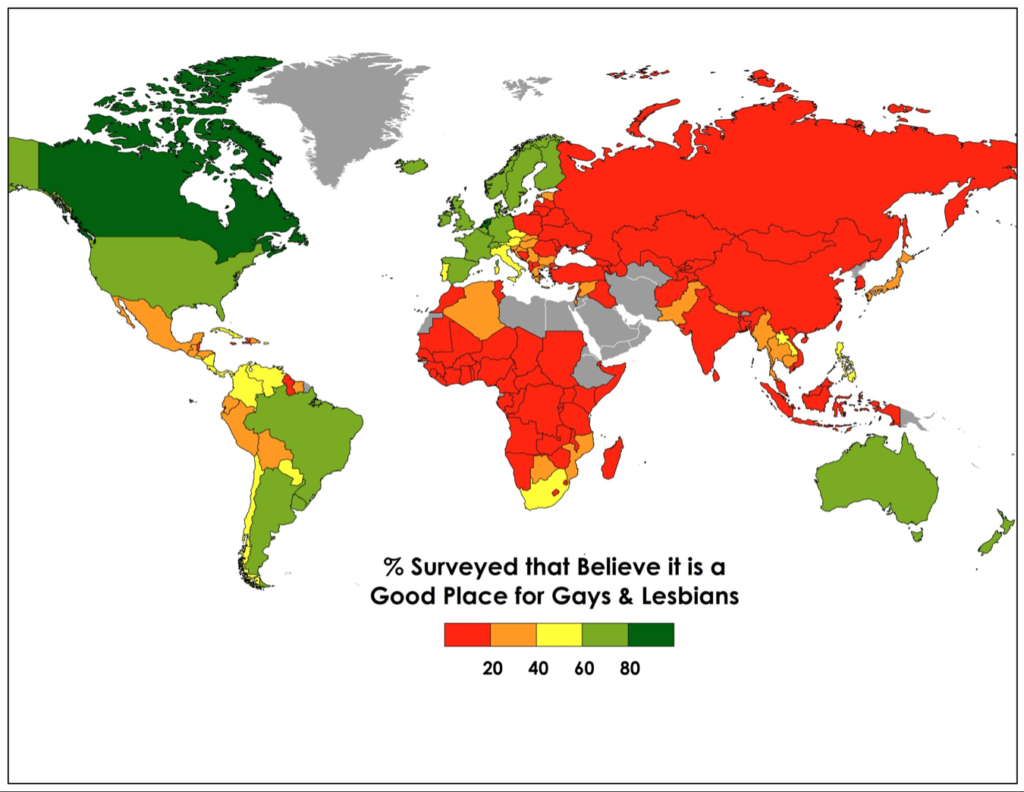
Credit: Martin Prosperity Institute
Answers for ACTION 3
Only #3, #8, #9 and #10 are FALSE
#3 FALSE.
Lesbians were not considered as harmful to the regime and wore the black triangle as anti-social prisoners.
#8 FALSE
Rosa Winkel is the German translation of pink triangle.
#9 FALSE
Incredibly, gay people were considered to be criminals and were denied compensation after the war. It was not until 2001 that the German government recognized gays as victims of the Nazi regime. By that time, most of the men were very elderly or deceased.
#10 FALSE
Gad Beck, the last known gay survivor, who was also Jewish, died on June 14, 2012.
Every effort has been made to gain permission from copyright holders to reproduce borrowed material. The publishers apologize for any errors and will be pleased to rectify them in subsequent reprints and website programming
Educator Tools


